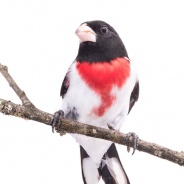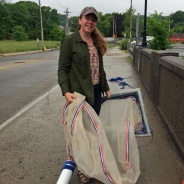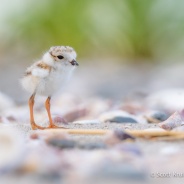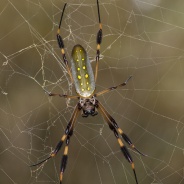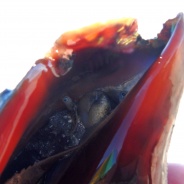I love this time of year. After the exuberance of summer and the vibrant colors of fall, I’m thankful for the days growing shorter. The nights longer. Temperatures falling. Silhouettes of bare branches against a leaden sky promising snow. All of nature winding down. Encouraging quiet. Reflection. Introspection. [more]
Rose-breasted Grosbeak
This is a male Rose-breasted Grosbeak (Pheuticus ludovicianus) photographed by RTPI President Twan Leenders in his backyard in Jamestown, NY. These are medium-sized songbirds with heavy, seed-crushing bills. In his ‘Field Guide to Birds of North America’, Roger Tory Peterson described their song as resembling that of the American Robin, but delivered with more feeling! Have you seen any at your backyard feeders this spring?
read moreBaby Skunk
As we enter mid-June we find ourselves in one of the quieter times of the avian season as nearly all of our northbound migrants have found their way to their nesting grounds. A few birds may still be trickling through, but most of what we see now is breeding in our region. This seasonal bird post is being hijacked to deliver another message with a Sunday skunk! Isn’t it adorable? I saw this baby skunk earlier this week, and it reminded me to put out a brief message about the many miniature mammals we see emerging as we head into summer....
read moreTake Cover!
For this Salamander Saturday, we thought we’d share a little video of one of our new residents, Tweeg, making his way under his hiding rock. Hellbender’s bodies are very flat and streamlined, which allows them to slide easily underneath large rocks sitting on a stream-bed. While under their rock of choice, hellbenders will wait patiently for prey to come near and will snatch them up for a quick meal. Currently, Oneka and Tweeg have some fish they share space with and occasionally snack on whilst under their...
read moreSafeguarding RTPI’s Unique and Irreplaceable Collections
Documentary Heritage & Preservation Services for New York (DHPSNY) is a statewide program of the New York State Archives and New York State Library which provides free planning and education services to archives, libraries, museums, and other institutions that safeguard and ensure access to New York’s historical records and unique research materials. Preparation for an emergency or disaster is one of the most important steps a cultural institution can take to safeguard collections. RTPI is the only official institutional steward of the...
read moreWhat’s In Our Water?
Have you seen this woman in the news lately? This is Dr. Sherri (Sam) Mason, the SUNY Fredonia Professor whose groundbreaking research on plastic pollution in the Great Lakes has earned her much recognition and press. RTPI staff have teamed up with Dr. Mason for guidance on evaluating the levels of plastic pollution in another freshwater system – the Chadakoin River in Jamestown. During our summer 2017 “education through conservation” initiative, the Project Wild America Youth Ambassadors Program (PWA), local students will work with RTPI...
read moreA Frog that Few Have Laid Eyes On
Here is a frog that few have ever laid eyes on – Legler’s Tree Frog (Ptychohyla legleri). This is one of the target species of RTPI Director Twan Leenders’ recent trip to the mountains of Costa Rica where he joined RTPI Research Associate Alex Shepack in surveys of imperiled amphibian populations. Legler’s Tree Frog is an endangered species with a very small and highly fragmented distribution range. It is the only species in its genus in lower Central America; its nearest relatives are found in northern Nicaragua and countries north of there....
read morePiping Plover Hatchling
This is a Piping Plover hatchling – only a few days old – foraging on the beach with its parents and siblings. The NBA has a campaign called, “This Is Why We Play”. This photo exemplifies why WE advocate, educate, and conserve species and their habitats in collaboration with the Audubon Alliance for Coastal Waterbirds. It is often difficult work in a challenging field for our staff and our volunteers. While we can sometimes lose sight of the bigger picture, this photo of a little bird reminds us that our efforts are...
read moreSpider Silk – the Next Sustainable Resource?
Spider silk is the world’s strongest natural fiber known – it is incredibly durable but also extremely lightweight and flexible. One strand of spider silk is one-tenth the thickness of a human hair, and its flexibility resembles that of thread. These qualities are unmatched by other fibers, such as cotton or nylon, giving it a wide variety of industrial applications. The value of spider silk is increased by the fact that it can be a renewable resource. RTPI conservation staff works with the Forman School during research expeditions in...
read moreGlass Frogs
Researchers from the Roger Tory Peterson Institute of Natural History (RTPI) have been monitoring Glass frogs and other amphibian species in Central America for more than two decades – not only to keep these frogs from extinction, but also to learn how some populations have been able to survive catastrophic declines due to the parasitic Chytrid fungus. Hopefully this information will help us as we try to find ways to help other endangered species as well. Glass frogs owe their common name to their transparent undersides which, in some...
read moreWhat in the Whorled?
On a recent visit to coastal Florida, a personal friend encountered what she though to be a vacant seashell, but soon discovered that it was in fact occupied by a feisty resident. Knowing my profession (and my affinity for what I affectionately refer to as “goobies”; the world’s slimy, obscure, and often over-looked and under-appreciated critters), she shared the photos she had taken in hopes that I could assist in identifying her find. Somewhat serendipitously, it turned out to be the very creature that I studied...
read more



